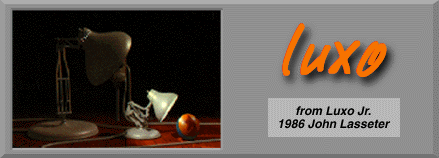![[Picture of Jr. Jumping]](luxo_strip1.gif)

It is a short film created by John Lasseter and company of Pixar in 1986. It employs a combination of keyframe animation and classical animation techniques.
This is a revolutionary film because it was the first animation that employed a fixed camera. That is, instead of the point-of-view soaring all around as it often does in computer animations, the view does not change. This is a very nice departure from the standard new-age-music, dancing triangle animation that is so often seen. It puts an emphasis on the characters, and helps develop the fact that Luxo Jr. is an entertaining film, not just a "neat" animation.
The film portrays two desklamps: the full-grown Luxo, and it's child-lamp Luxo Jr. It began when Lasseter was modeling a desklamp, and started thinking about babies; he asked himself the question "What would a baby desklamp look like?" The answer, of course, is Luxo Jr.
What is fabulous about this film is the lifelike characteristics that Lasseter gives these lamps, without changing their physical appearance. This technique is a Lasseter trademark: giving life to his once-inanimate characters not by obvious human eyes, mouths, or hands, but instead by applying the concepts of animation.
These characters were so enjoyable that PBS contracted Lasseter to do an educational short for Sesame Street, called Light and Heavy. In this film, Luxo and child demonstrate the properties of weight, and inderectly, Newton's first law: f = ma.
![[Picture of Jr. Jumping]](luxo_strip1.gif)
Watch Jr. jump. It's pretty amazing. Lasseter uses classical animation techniques to make these jumps so life-like. Note that it is not just Jr. through the air and to a new landing place. Jr. anticipates: he bends his springs like a human would bend his knees, and his "head" looks down. Jr. then springs up, stretches himself out in the air, and lands. He then reacts to the landing, again bending his springs to break his fall.
![[More Pictures of Jr. Jumping]](luxo_strip2.gif)
Lastly, and most-importantly, note that the story is enjoyable. It's funny, and even if the animation weren't top notch, we would still laugh. This is an enjoyable, memorable film.
 Clip: Luxo Jr. (2.31M, SGI)
Clip: Luxo Jr. (2.31M, SGI)